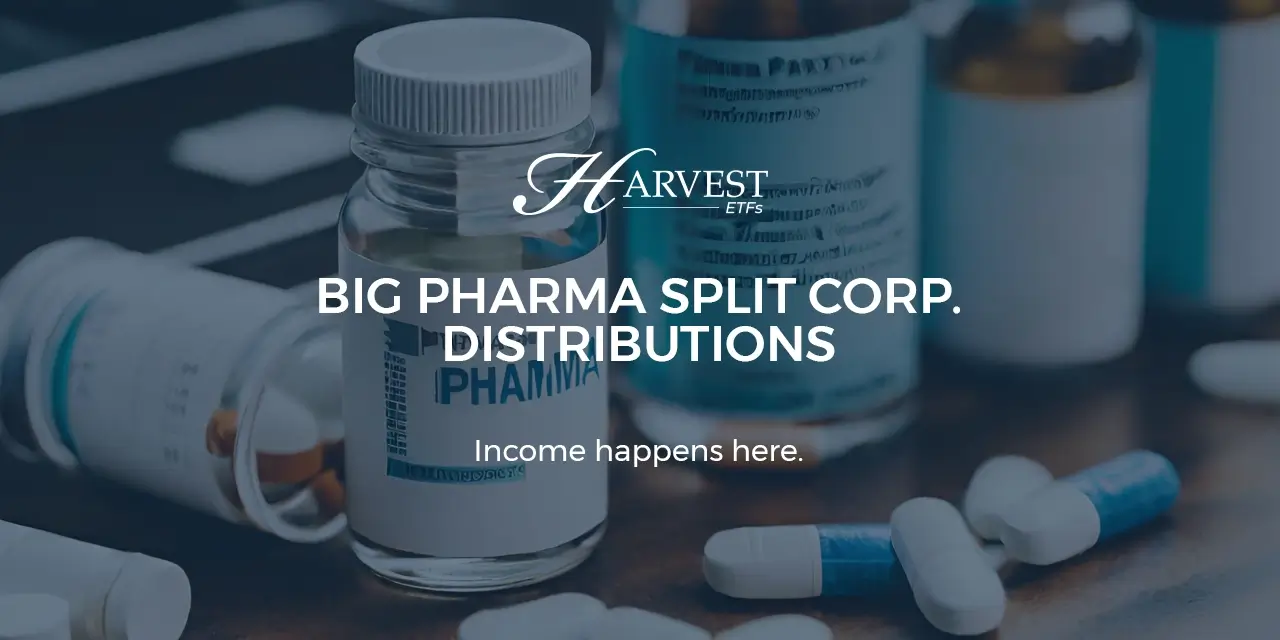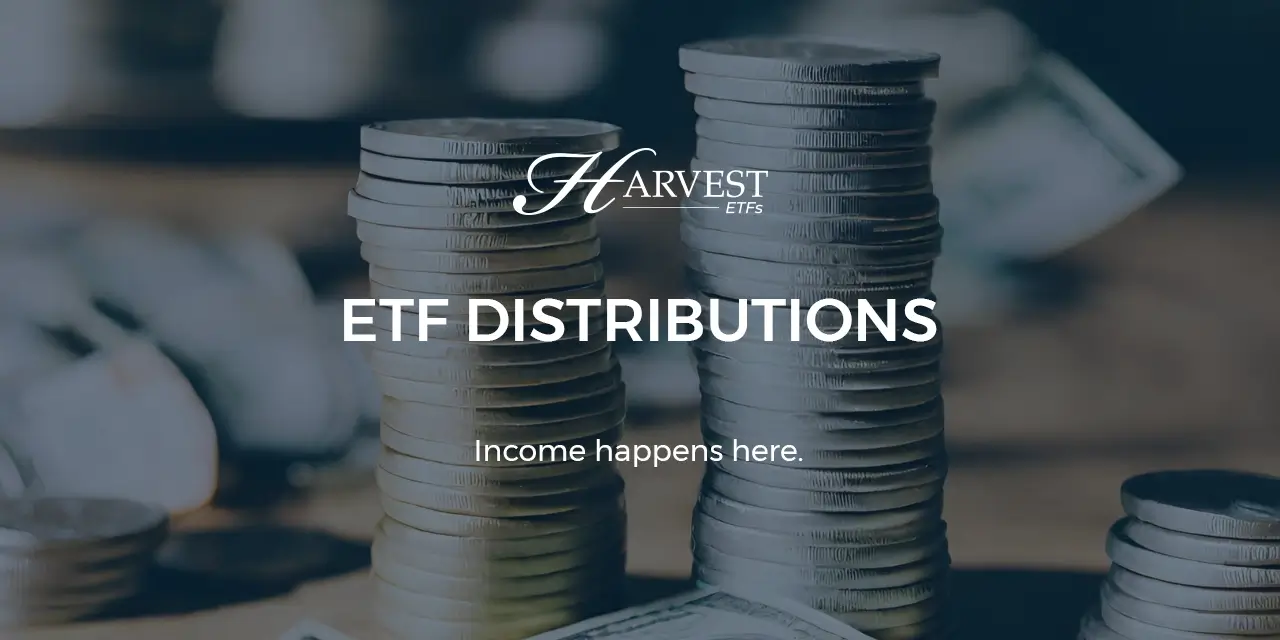Investor sentiment has been below average due to persistent inflation, market volatility, and weak performance from bond markets. To build a more resilient portfolio, many investors are turning to Canadian-listed ETFs, high yield ETFs, and covered call ETFs that deliver monthly income and can help with cash flow needs and overall returns.
Harvest ETFs are specifically designed to align with long-term investment objectives, with the goal of maintaining resilience even when faced with market volatility. Our covered call ETFs is based on an investment process that blends sector analyses , data modeling and analytics with an established record in covered call writing to assist investors in navigating unpredictable market conditions.
Harvest’s Income ETFs – equity based, employ covered call strategies to generate cash flow from a selection of top-performing companies, helping individuals meet their retirement financial goals while seeking to protect their initial investments. By integrating covered call ETFs into their investment portfolios, investors have the potential to increase their income streams and better manage risk during periods of unpredictable market conditions . Covered call options can offer downside protection against potential losses in the value of the underlying stocks. In other words, if the market is turbulent, the premiums earned from selling call options can help cushion the impact of declining stock prices.
Why Covered Call ETFs Work in Volatile Markets
In the current market climate, the right investment strategy is key to resilient investing. The traditional 60/40 allocation to stocks and bonds has been undermined by under performance in recent months. In this environment, covered call ETFs have the potential to provide value as an asset class for investors seeking resilience.
Covered call ETFs are designed to deliver consistent monthly income, which may be considered a significant component of overall return in challenging market conditions. First, they have the potential to assist in generating diversified income or balancing objectives between growth and income, especially in a rising market. When utilizing a covered call ETF, investors may be able to stabilize the income profile of a portfolio with either monthly or quarterly distributions, as opposed to the semi-annual dividend payments that many companies typically offer. Second, covered call ETFs are designed to provide a steady income stream, making them a popular choice for investors seeking to generate additional cash flow. Finally, covered call ETFs might serve as a suitable option for investors seeking some protection against volatility.
The Harvest Diversified Monthly Income ETF (HDIF:TSX) combines the prudence of diversification with the power of covered call strategies with modest leverage to create a high yield ETF. By holding a portfolio of existing Harvest equity income ETFs, HDIF can help investors seeking a product with enough diversification to deal with potential shocks like inflation, drop in performance of a single stock or rising interest rates. At the same time, by holding positions in a wide array of equity sectors it can still participate in market growth potential.
In a market where investors are seeking resilience from their investments, the consistent high yields generated by covered call ETFs make these products into an attractive asset class. Within the covered call ETF asset class however, investors may want to consider the specific sector they’re investing in.
Choosing a Sector-Specific Covered Call ETF
Many investors will seek out specific sectors as they try to build resilient portfolios. Traditionally defensive equity sectors like consumer staples have helped investors weather troubled times and economic downturns. Combining a sector like that with a covered call strategy can help investors achieve the resilience they’re seeking. However, it’s important to pick the right sector.
In today’s environment of high inflation, and especially high commodity costs, the large-cap US healthcare sector is showing signs of resilience. Large-cap healthcare companies have a combination of low commodity price exposure, high profit margins, and consistent demand. When consumers are feeling the pinch, they’ll cut spending on their Netflix subscription before they stop spending on prescription drugs.
Harvest Healthcare Leaders Income ETF (HHL:TSX) captures the US large-cap healthcare sector and combines it with a covered call strategy to generate high income yields. While the healthcare sector is broadly attractive, it’s also a highly technical investable universe. Healthcare has a wide array of subsectors with unique strengths and weaknesses. The sector also has a large number of riskier small companies that grab headlines and attention but lack the resilience of some large players.
When considering a sector for resilience, and especially when combining it with a covered call strategy, the experience and quality of the ETF’s management team is key.
Monitoring & Rebalancing
Ongoing monitoring and rebalancing are essential practices to maintain the effectiveness and alignment of sector-specific covered call ETF investments. The dynamics of sectors can change over time due to various factors, including economic conditions, technological advancements, regulatory changes, and market sentiment shifts.
Regular monitoring allows investors to stay informed about the performance and outlook of the sector the ETF is focused on. By keeping a close eye on relevant news and sector-specific developments, investors can identify potential risks and opportunities.
Rebalancing is equally as important. It involves periodically adjusting a portfolio to bring it back in line with the original asset allocation targets. In the context of sector-specific covered call ETFs, rebalancing may involve adjusting options positions and strike prices to align with income goals and risk tolerance.
For instance, if a sector experiences a significant run-up in stock prices, investors may want to adapt their covered call strategy to capture more income while managing potential capital gains risk.
These actions help investors navigate changing market conditions, seize opportunities, and ensure their portfolios remain well-diversified.
Management Experience and Covered Call ETFs
Expert management is key to resilient covered call ETF investing during a volatile market. While retail investors’ greatest strength in an environment like this is to take a long-term view, professional portfolio managers have the tools to take advantage of opportunity in volatility. Covered calls, when actively managed, are able to generate higher premiums during volatile times.
When markets are choppy, call options—the opportunity to buy a stock at today’s price at a later date—are in higher demand. Passive, rules-based covered call ETFs that require covered calls to be written at a consistent level every month are constrained in a volatile market and can’t offer the same advantages. This can result in missed opportunities for income generation or downside protection when market conditions shift rapidly. Moreover, these ETFs may have less flexibility in selecting call strike prices or adjusting the covered call strategy to suit market dynamics. While they provide exposure to covered call strategies, passive ETFs may lack the customization that active management can offer, which could impact their overall performance in volatile or changing markets.
An actively managed covered call ETF can therefore generate higher premiums from their call options in a volatile market. This dynamic approach allows them to select the most promising stocks for writing call options, potentially enhancing income generation. Additionally, active management enables swift adjustment to market developments, helping mitigate risk during volatile times. The strategic use of covered calls provides a consistent income stream from option premiums, which can be particularly attractive in low-yield environments. By participating in potential stock price gains up to the call strike price, investors can capture some upside potential, although limited, while enjoying a layer of protection in the form of call premiums.
Investors seeking a resilient covered call ETF may want to look at the rules governing a particular ETF’s covered call strategy. They may also want to look at the experience of the management team and the scale of an ETF issuer’s call option writing. If an ETF issuer writes a huge volume of call options, or has a management team that has taken call option strategies through significant market downturns, those can be signs of skilled managers and a powerful investment philosophy that can help secure an ETF’s resilience.
Commissions, management fees and expenses all may be associated with investing in HARVEST Exchange Traded Funds managed by Harvest Portfolios Group Inc. (the “Funds” or a “Fund”). Please read the relevant prospectus before investing. The Funds’ returns are not guaranteed, their values change frequently, and their past performances may not be repeated. Tax, investment and all other decisions should be made with guidance from a qualified professional. The above is for general information purposes only and does not constitute advice or a solicitation to buy or sell the securities referred to within.














